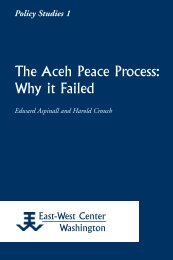Constructing Papuan Nationalism: History, Ethnicity ... - ScholarSpace
Constructing Papuan Nationalism: History, Ethnicity ... - ScholarSpace
Constructing Papuan Nationalism: History, Ethnicity ... - ScholarSpace
- No tags were found...
You also want an ePaper? Increase the reach of your titles
YUMPU automatically turns print PDFs into web optimized ePapers that Google loves.
<strong>Constructing</strong> <strong>Papuan</strong> <strong>Nationalism</strong> 81has become subdued. At the time of writing, the public expression of<strong>Papuan</strong> nationalism and the mobilization of support for independencewere for the most part greatly restricted due to countermeasures taken bythe Indonesian government. <strong>Papuan</strong> leaders, including those holding seniorpositions in the administration, were now under considerable scrutinyand pressure. In addition, the prospective division of the province was testingthe strength of pan-<strong>Papuan</strong> identity and political solidarity. The relativelyopen political space created during the “<strong>Papuan</strong> Spring” seemed likeanother country.Nevertheless, beneath the surface, <strong>Papuan</strong> identity and commitmentto independence remains stronger and more widespread than it was in1961 and 1962. Those involved in the 1961 movement had been drawnprimarily from a small elite that had been educated, politicized, andemployed in the urban centers of Netherlands New Guinea. From the perspectiveof today, they were the pioneers of <strong>Papuan</strong> nationalism. Comingfrom diverse regional and ethnic backgrounds, they were the first to articulatean identity as <strong>Papuan</strong>s. Yet they were a relatively restricted core ofactivists. When the Komite Nasional issued its Manifest and the NewGuinea Council agreed that the Morning Star flag should be displayed asthe symbol of Papua, many of the elites outside Hollandia were dismayed.They felt that they had not been informed and that the decisions of theKomite Nasional and the Council had been imposed upon them (van derVeur 1963: 65). The restricted nature of the nationalism of the time canbe seen furthermore in the local reactions to the flag raisings of 1961,which appeared to have meaning only for the elites of the towns. Forexample, the Dutch Controleur of Mimika, in the Residency of Fakfak,reported that the flag raising ceremony there had attracted some interestbut little understanding among the local population, who had only avague idea of what the word “<strong>Papuan</strong>” meant. At that time, most peoplethought not in terms of Papua, but in terms of locality and region. It wasbeing part of Mimika that had meaning. 136 Consequently, when in late1962, during the first days of the UNTEA administration, Indonesianofficials first came into direct contact with <strong>Papuan</strong> nationalists, they foundthat they posed much less of a threat to their authority than anticipated.Indonesia had planned on having to employ a high degree of militaryrepression and had also made provision for political indoctrination, butduring the UNTEA administration it quickly realized that these measureswould not be necessary, as for the most part the nationalists had failed to
















